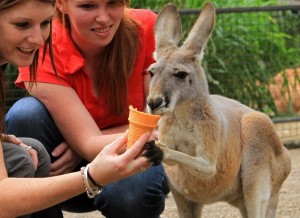Fences, cages, and glass barriers — typical components built into my schema of a zoo. And not a bad concept it was until (very often) the animals would simply turn away and retreat into hiding. Not to mention, the incredibly large spaces of the enclosed areas, just enough for excited zoo-goers to squint their eyes and make out the little animal in the corner.
After coming across Featherdale Wildlife Park, a hands-on zoo mentioned in Elaine Au’s blog, I could not wait to do some research of my own. From an animal-lover’s perspective, it is certainly most appealing to come across a zoo that permits interactions with the wildlife. While I am curious to find out how Featherdale has established a way to deter potential issues that may arise from removing barriers between customers and animals, I think this is a fantastic way for the zoo to separate itself from the competition. While it is fairly ordinary for zoos, globally, to have some sort of distance and feeding restriction, as Elaine mentioned, a common value for customers is simply not being fulfilled — the want to get up close and personal to these creatures. Unfortunately, to many zoos and similar organizations, the risk of having one radical customer putting the wildlife at harm is enough to decline the general public such a value proposition. However, if Featherdale Wilfelife Park is able to sustain a unique value proposition that many zoos fear to provide, it will be able to retain it’s competitive edge and change the way many of us view a “zoo” to be.
Elaine’s Blog: http://blogs.ubc.ca/auyikningelaine/
BBC article: http://www.bbc.com/news/business-29369091
Featherdale Wildelife Park Website (Image taken from here): http://www.featherdale.com.au/
